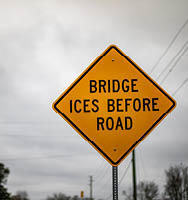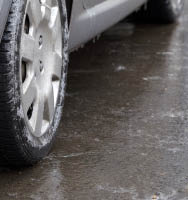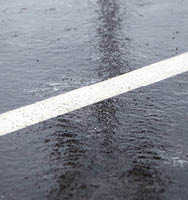
When the temperature falls below 32 degrees, black ice on the roads becomes a risk while driving. Black ice is sometimes called clear ice or transparent ice because it’s very hard to see. The thin nature of black ice is a lot like a glazed donut—it can be hard to see the glaze unless there’s the right lighting. Cloudy winter days and dark nights make black ice difficult to detect as well. Plus, black ice is so thin it can be easily mistaken for typical black pavement on the road.
If you’re wondering how to drive on black ice, you’re in the right place. We’ll cover weather conditions where black ice is likely to form, how to pinpoint black ice, and tips for driving on black ice if you’re ever in that position.
When is black ice likely to occur on the road?
Black ice will form at or around freezing temperatures, or 32 degrees Fahrenheit. The Weather Channel says, “If the temperature rises above freezing or the sun comes out during the day, any snow on the ground will slowly melt and cause road surfaces to become wet. If it rains, that could also lead to wet roadways with some puddles. If the temperature then drops below freezing while the ground is still wet, black ice will likely form on paved surfaces due to the refreezing."
Black ice is very likely to develop on shaded road surfaces, especially if the area has very little sun throughout the day. For bridges and overpasses, the airflow underneath keeps the road cold and more susceptible to clear ice.
Next time you drive over a bridge, look for these Bridge Ices Before Road signs:

How to pinpoint black ice
Black ice is very dangerous because it’s so difficult to see. At night, it’s nearly impossible to detect. Here are a few things to watch on the pavement while you’re driving during freezing temperatures:
- Dry roads are matte with no shine and may even be coated in salt or road brine to prevent ice formation.
- Wet roads are shiny and darker than dry roads. Puddles and splashing water from moving cars make this one easy to detect, even during night driving. The roads will be wet if the temperatures are slightly above freezing temperatures. Or, if the sun has recently set, the temperatures will fall soon.
- Icy roads also look shiny. In many cases, light reflects off the ice creating a mirror-like effect. Icy roads can also look like still, wet roads. Be sure to drive with caution if the roads look icy or if the temperature is below 32 degrees outside.
- Black ice has two differentiating qualities from other pavement conditions—the road surfaces look darker than dry roads, but also dull. You may be able to spot patches of black ice in the daytime, but at night it will be nearly impossible.
Here are two examples of black ice on the road. Notice how the road is dull and has minimal texture that makes the ice difficult to see.



Learn about our
Auto Insurance
Tips for driving on black ice
You’ve gathered by now that it’s tough to spot black ice. In the event you end up driving on black ice and have little time to react, here’s what you can do:
- Take your foot off the gas pedal to start slowing down at a gradual pace as you slide.
- If you continue to slide down the road on the correct path, keep the steering wheel straight and very slowly press the brakes until you come to a complete stop or continue out of the patch of ice slowly. Your approach here will depend on the amount of black ice and if you’re traveling on a winding road.
- If your vehicle begins to slide to the side, don’t slam on the brakes. Slowly drop the brake pedal as you turn the steering wheel in the same direction that you’re sliding. This approach works best if you keep a large following distance from other vehicles. In dry, above-freezing conditions you should follow the three-second rule. However, on icy roads, you should consider at least doubling that following distance and decreasing your speed.
- When you come to a complete stop, you might need some help! Roadside Assistance from Integrity can help with towing services, fuel delivery and more.
Care to learn more about driving in snow or ice? Check out
this winter driving blog for more information. To add Roadside Assistance to your auto insurance policy, talk to your Integrity Independent Agent today.
References
The Weather Channel
U.S. Department of Agriculture Forest Service
The Village of Niles, IL
DriversEd.com
Coverages described herein may not be available in all states. Please contact a local independent Integrity agent for complete details on coverages and discounts. If the policy coverage descriptions herein conflict with the language in the policy, the language in the policy applies. For the coverage to apply, a claim must be made and reported during the policy period. Scenarios above are not actual claims. The material provided above is for informational, educational, or suggestion purposes and does not imply coverage. WE RESERVE THE RIGHT TO REFUSE TO QUOTE ANY INDIVIDUAL PREMIUM RATE FOR THE INSURANCE HEREIN ADVERTISED. Integrity Insurance policies are underwritten by Integrity Insurance Company, an affiliate of Grange Insurance Company, and Integrity’s subsidiaries. Integrity companies not licensed in Pennsylvania. Not all Integrity companies are licensed in all states.